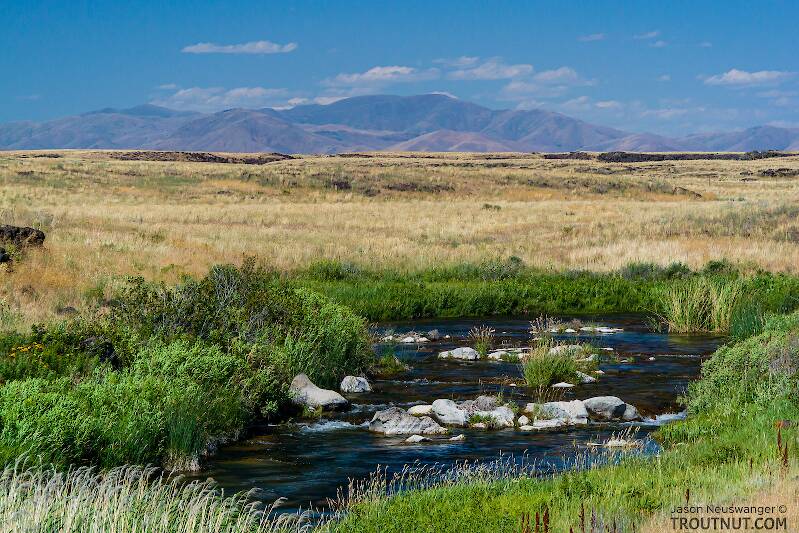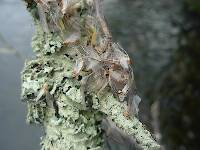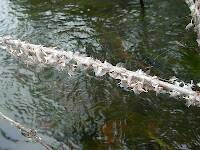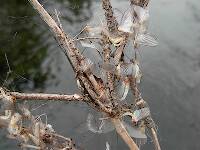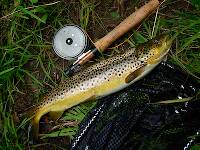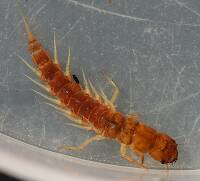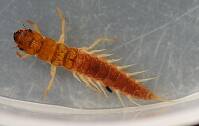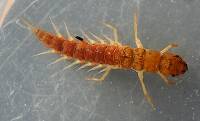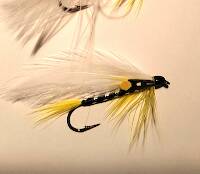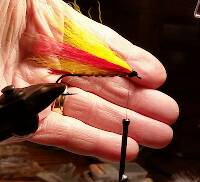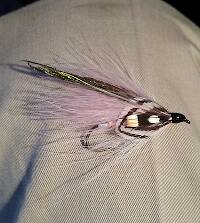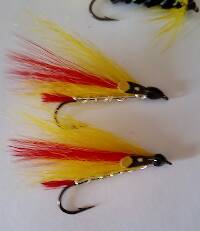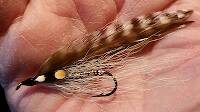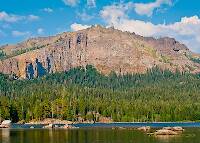
Blue-winged Olives
Baetis
Tiny Baetis mayflies are perhaps the most commonly encountered and imitated by anglers on all American trout streams due to their great abundance, widespread distribution, and trout-friendly emergence habits.
Featured on the forum

Troutnut is a project started in 2003 by salmonid ecologist Jason "Troutnut" Neuswanger to help anglers and
fly tyers unabashedly embrace the entomological side of the sport. Learn more about Troutnut or
support the project for an enhanced experience here.
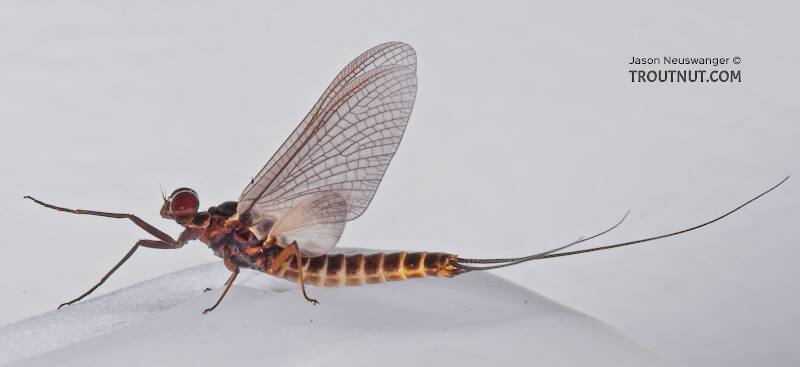
This Leptophlebia cupida dun was extremely cooperative, and it molted into a spinner for me in front of the camera. Here I have a few dun pictures and one spinner picture, and I've put the entire molting sequence in an article.
Konchu on Mar 30, 2007March 30th, 2007, 3:10 pm EDT
Saw a nice Leptophlebia cupida/nebulosa spinner today while I was sitting on the front porch; it met its demise in my wife's soda, unfortunately. That's the first one I've noticed this year. What else, if anything, is everyone seeing so far this spring? The Ameletus from the stream behind my house will be hatching soon, maybe yet this weekend, if the weather cooperates.
Troutnut on Mar 30, 2007March 30th, 2007, 3:18 pm EDT
I just went nymph-collecting. Some very tiny stonefly adults (Nemouridae maybe) turned up in my kick-net sample, with a few matching nymphs.
The only nymphs I caught with darkened hatch-ready wingpads were Paraleptophlebia and some Baetid mayfly.
I'm photographing now.
The only nymphs I caught with darkened hatch-ready wingpads were Paraleptophlebia and some Baetid mayfly.
I'm photographing now.
Jason Neuswanger, Ph.D.
Troutnut and salmonid ecologist
Troutnut and salmonid ecologist
Konchu on Mar 31, 2007March 31st, 2007, 1:46 am EDT
Troutnut, I'd be interested to see the Paraleptophlebia nymph. Could you rear out some male spinners?
Troutnut on Mar 31, 2007March 31st, 2007, 2:01 am EDT
Unfortunately no... they died pretty quickly. :(
Hopefully I'll catch some more before it's time for them to hatch.
Hopefully I'll catch some more before it's time for them to hatch.
Jason Neuswanger, Ph.D.
Troutnut and salmonid ecologist
Troutnut and salmonid ecologist
Joec on Feb 24, 2008February 24th, 2008, 1:17 pm EST
I believe this is the same species which hatches shortly after ice-out in many of our remote trout ponds in Maine and NH. I have experienced good fishing to both the duns and nymphs, no matter the weather. The hatch usually commences around memorial day. Does anyone else have experience with this hatch and do you think I have the genus at least correct? I am confused because much of which I have read suggests that leptophlebia are found in my region in lower elevation streams.
Any help is appreciated!
Any help is appreciated!
Taxon on Feb 24, 2008February 24th, 2008, 2:40 pm EST
Joe-
It may (or may not) be the same species, as Maine and New Hampshire have (4) species of Leptophlebia, L. cupida, L. intermedia, L. johnsoni, and L. nebulosa. However, both the emergence timing and the water type you describe would seem appropriate. In answer to your stated confusion, Leptophlebia species are most often found in very slow moving pools of some streams, and in shallow ponds.
It may (or may not) be the same species, as Maine and New Hampshire have (4) species of Leptophlebia, L. cupida, L. intermedia, L. johnsoni, and L. nebulosa. However, both the emergence timing and the water type you describe would seem appropriate. In answer to your stated confusion, Leptophlebia species are most often found in very slow moving pools of some streams, and in shallow ponds.
Joec on Feb 25, 2008February 25th, 2008, 5:27 am EST
Thanks Roger. My pond-dwelling Leptophlebia is a much anticipated event especially in the Moosehead Lake region of Maine. There are countless ponds which contain these insects. Most local fly fishermen refer to this hatch as the "hendrickson hatch". Of course they call most all brown/rusty mayflies "hendricksons". In august on the Kennebec near Bingham there is a dependable spinner fall of Isonychia and these too are labeled "hendricksons". For the visiting fisherman obtaining accurate hatch info can be difficult. Things are changing, however slowly!
Taxon on Feb 25, 2008February 25th, 2008, 7:15 am EST
Joe-
Identifying stillwater inhabiting mayflies is somewhat less complicated than is identifying those inhabiting moving water, as there are only (6) genera of the former in N. America of which I am aware, those being Caenis, Callibaetis, Hexagenia, Leptophlebia, Siphlonurus, and Tricorythodes.
My pond-dwelling Leptophlebia is a much anticipated event especially in the Moosehead Lake region of Maine. There are countless ponds which contain these insects. Most local fly fishermen refer to this hatch as the "hendrickson hatch". Of course they call most all brown/rusty mayflies "hendricksons".
Identifying stillwater inhabiting mayflies is somewhat less complicated than is identifying those inhabiting moving water, as there are only (6) genera of the former in N. America of which I am aware, those being Caenis, Callibaetis, Hexagenia, Leptophlebia, Siphlonurus, and Tricorythodes.
Troutnut on Feb 25, 2008February 25th, 2008, 7:18 pm EST
This isn't really relevant to the Leptophlebia topic, but I just wanted to comment that Roger left Ephemera and Ephoron off the list. There are major stillwater populations of both.
Of course, if we were nitpicking, I'm sure we could find dozens of obscure mayfly genera with a few stillwater populations here and there, but those two are pretty major.
Of course, if we were nitpicking, I'm sure we could find dozens of obscure mayfly genera with a few stillwater populations here and there, but those two are pretty major.
Jason Neuswanger, Ph.D.
Troutnut and salmonid ecologist
Troutnut and salmonid ecologist
Taxon on Feb 25, 2008February 25th, 2008, 9:21 pm EST
Jason-
I stand corrected, as Ephemera simulans is found in mid-Western lakes. However, I believe Ephoron species require moving water. Which Ephoron species do you understand to inhabits ponds or lakes?
I stand corrected, as Ephemera simulans is found in mid-Western lakes. However, I believe Ephoron species require moving water. Which Ephoron species do you understand to inhabits ponds or lakes?
Troutnut on Feb 26, 2008February 26th, 2008, 4:30 am EST
E. simulans is found in one of the Finger Lakes in upstate NY, too.
I don't know whether it was Ephoron leukon or Ephoron album, but I vividly recall motoring through a thick emergence of Ephoron across Lake Owen in northern WI. So that's personal experience; I don't remember reading something to back it up.
I don't know whether it was Ephoron leukon or Ephoron album, but I vividly recall motoring through a thick emergence of Ephoron across Lake Owen in northern WI. So that's personal experience; I don't remember reading something to back it up.
Jason Neuswanger, Ph.D.
Troutnut and salmonid ecologist
Troutnut and salmonid ecologist
Taxon on Feb 26, 2008February 26th, 2008, 4:58 am EST
Jason-
I don't doubt your experience. When stoneflies can survive on constantly waveswept shores of certain large lakes, just about anything seems possible.
I don't doubt your experience. When stoneflies can survive on constantly waveswept shores of certain large lakes, just about anything seems possible.
Quick Reply
Related Discussions
Topic
Replies
Last Reply
1
Jan 15, 2018
by Millcreek
by Millcreek
5
Aug 7, 2007
by Wiflyfisher
by Wiflyfisher
1
Nov 9, 2006
by Troutnut
by Troutnut

